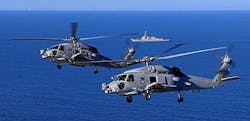Raytheon to provide Multispectral Targeting Systems to Australian navy in $10.5 million contract
Officials of the Naval Surface Warfare Center Crane Division in Crane, Ind., announced a $10.5 million contract Monday to the Raytheon Space and Airborne Systems segment in McKinney, Texas, to provide the Royal Australian Navy with the AN/AAS-52 Multispectral Targeting System (MTS) for Australia's MH-60 helicopters.
The Raytheon MTS is a turreted forward-looking pod combining several visible-light and infrared video cameras for long-range surveillance and high-altitude target acquisition, tracking and laser designation.
Multispectral sensors captures image data at specific frequencies, and separate the wavelengths to extract information the human eye fails to capture with its receptors for red, green and blue. It can detect things like disturbed dirt, and can be effective in finding targets hidden in camouflage.
This contract involves foreign military sales to Australia. The contract involves Raytheon MTS turret units, electronic units, and power converters for the Australian MH-60 helicopter.
The Australian navy's MH-60R Seahawk helicopter is for anti-submarine and anti-surface warfare. The rotorcraft can be flown from small surface warships like frigates and destroyers, as well as from large ships like aircraft carriers.
Other versions of the The Raytheon MTS can be fitted to the C-130 fixed-wing aircraft, and the medium-altitude long-endurance MQ-9 Reaper hunter-killer unmanned aerial vehicle (UAV).
The MTS offers a combination of sensors that include multiple-wavelength sensors; near-infrared and color daylight TV cameras; illuminators; eye-safe rangefinders; image merging; spot trackers; and similar other avionics.
The system offers surveillance, target acquisition, tracking, rangefinding, and laser designation for the Hellfire missile and for U.S. and NATO laser-guided munitions such as the Paveway laser guided bomb. The advanced targeting forward looking infrared (ATFLIR) pod also is used with used with Paveway, JSOW, and HARM bombs and missiles.
On this contract Raytheon will do the work in McKinney, Texas, and should be finished by April 2017.
For more information contact Raytheon Space and Airborne Systems online at www.raytheon.com, the Naval Surface Warfare Center-Crane at www.navsea.navy.mil/nswc/crane, or the Royal Australian Navy at www.navy.gov.au.
